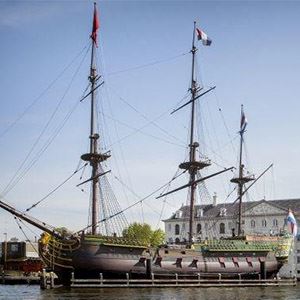
14. On the jetty: East Indiaman Amsterdam
This wooden three-master, 150 feet long and with 32 cannons, is a full-size replica of the East Indiaman Amsterdam. In the eighteenth century, cargo ships like these – the biggest of their kind – carried merchandise between Asia and Europe. In 1749, the Amsterdam left the island of Texel bound for Batavia on its maiden sea voyage. There was a crew of 203 on board, along with 127 soldiers and 5 passengers. However, a severe storm in the English Channel wrecked the ship off the south coast of England, where a large part of the hull still remains. Archaeologists have raised items left on board the ship, some of which are now in the National Maritime Museum’s collection. This reconstruction was made between 1985 and 1990 in Amsterdam. Blueprints for a similar ship from the museum’s collection were used for the design, along with an eighteenth-century model ship from the Rijksmuseum’s collection.
If you would like to hear more about the history of the Dutch East India Company, press A.


The National Maritime Museum
Het Scheepvaartmuseum (The National Maritime Museum) shows the strong connection between the maritime world and society as a whole, and more specifically the impact of this on the lives of many individuals. The collection of The National Maritime Museum is one of the largest and most notable maritime collections in the world with approximately 400,000 objects, including paintings, models of ships, navigation instruments, and maps of the world. Discover 500 years of Dutch Maritime history as well as its strong links to today’s society and the society of the future.
- Kattenburgerplein 1
- Amsterdam Netherlands
- (020) 52 32 222
- www.hetscheepvaartmuseum.nl
